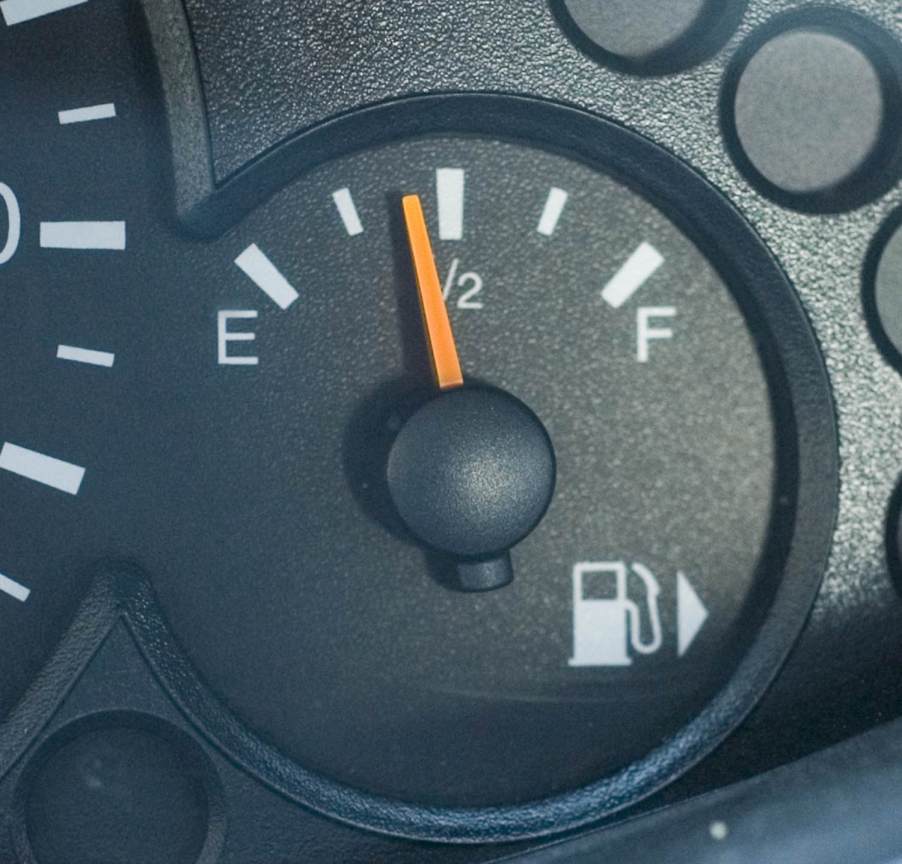
What Do E and F on a Car Dashboard Gauge Actually Mean?
If you think that the “F” on your dashboard fuel gauge stands for “full” while the “E” stands for empty, think again. Your car or truck is probably not empty when the needle hits “E.” Most automakers build in a reserve of several gallons. In fact, some argue that the “E” actually stands for “emergency.”
How does a fuel gauge work?
The fuel gauge in the dashboard of your car or truck shows the level of the fuel in your tank. The gauge accomplishes this by reading a float built into that tank.

When the automaker first assembled your vehicle, they installed a movable float in its gas tank. As the fuel level rises, so does the float. It moves a metal arm connected to an electronic resistor at the top of the tank, and varying the current sent to the gauge. This is why your fuel gauge moves from “F” to “E” as you burn gas.
But how full is “F?” And is “E” actually empty? Automakers can actually calibrate how the gauge will communicate the float position, and may be using it to manipulate you.
See how your fuel gauge works for yourself in the video below:
What does ‘F’ on my fuel gauge mean?
The “F” on your fuel gauge means “full.” When the float in your gasoline or diesel tank is at its highest position, the needle should be on or near the “F.”
I know I’ve had vehicles that I could fill past “F.” So if I topped off the tank, the needle would sit right at “F” for the next 50 miles, then start to pass through the rest of the gauge.
Depending on your fuel gauge calibration, “F” may actually mean a bit less fuel than full. But it’s not critical that you know how precisely how full your tank is when you have plenty of gas to get home.
What does ‘E’ on my fuel gauge mean?
Some say that the “E” on your fuel gauge means “empty,” even though almost every vehicle still has a gallon or two of fuel reserve below “E.” But others have claimed that–because the tank isn’t technically empty at “E”–this letter truly stands for “emergency.”

Most automakers calibrate their fuel gauge needles to land right on “E” a gallon or two before the tank is truly empty. There may be a few reasons for this, but they are all to help you out.
The first is the most obvious: If you are cutting it close, and running your car down to “E,” having a gallon or two of extra fuel you don’t know about may be the difference between getting to the pump or stalling out stranded. Instead of an “E” some vehicles have an “R” for “reserve.” But of course, knowing about this reserve makes it more likely that you’ll push a tank further and run out of gas.
Secondly, just a slosh of fuel in the bottom of the tank may not be enough to get you to the pump. Most vehicles draw fuel out of the rear of their gas tank, so they are less likely to run out while climbing a hill. But this means that with a bit of gas left in the tank, you could stall out while driving down a hill. It’s a good idea not to run it down to the very bottom.
Finally, an older vehicle (we’re talking ten years, twenty years, or even older) may have some rust or other debris in its fuel tank. During normal operation, this litter may sink to the bottom of the tank and give you no trouble. But if you were to suck the final gallon or two out of your tank, this junk might clog up your fuel filter.
Most automotive journalists assume that the “E” on your fuel gauge means “empty”–even though this is an exaggeration. But the folks over at TotalEnergies.id argue that “E” stands for “emergency” as in, “this is an emergency, you are about to run out of fuel, get to a filling station.”
Next, find out why you should run away from a used car with tape stuck to its dashboard or find out how far you can drive after your fuel gauge hits “E” in the video below:





